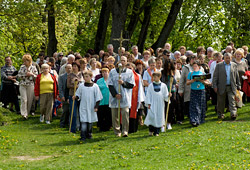Way of the Cross
Vilnius Calvary is divided into two parts. The Path of Christ’s Arrest comprises 20 stations, beginning with “the Last Supper Room” and ending at “the Fourth City Gate”. The stations are marked by 8 stone chapels, a bridge over the Cedron stream, a wooden chapel on that bridge, 1 stone gateway and 7 wooden gateways. The second part, known as the Path of Christ’s Cross, includes 15 stations, from “Pilate’s Praetorium” to “Mount Golgotha”, denoted by 12 stone chapels and 3 stations inside the building of the church. Jerusalem’s topography is replicated with maximum precision both in the distances between the stations and in the arrangement of the various parts of “the city of Jerusalem”. For instance, the distance between “Pilate’s Praetorium” and “the Removal from the Cross” is exactly 1,321 steps, and that between “the Mount of Olives” and “the Crucifixion” is 6,000 steps, while there are 1,000 paces between “Caiphus” and “Pilate”, and 350 paces between “Pilate” and “Herod”.
Many 17th century “Calvaries” give high honour to the Mother of God, and Vilnius Calvary is not an exception. A special Marian Path includes 12 stations, which start at “the Lord’s Tomb” and proceed, in the direction opposite that of the Way of the Cross, to “the Last Supper Room”. But devotion to Our Lady of Sorrows is less developed at Vilnius Calvary than, for example, at Samogitian Calvary or at similar shrines in Poland. Here attention is very much focused on the Crucified One and his Holy Cross, a perspective that is consciously and beautifully expressed both in the thoughtful layout of the structures and in the skilful use of distinctive features in the landscape. That focus is something unique to Vilnius Calvary.








